Are you ready to uncover the secrets to perfecting the art of sketching a dripping candle?
In this guide, we will show you step by step how to create a realistic and captivating representation of a melting candle.
Did you know that candles have been used for centuries, with the earliest known candles dating back to ancient China and Egypt?
Now, let’s dive into the world of art and bring a melting candle to life on our canvas. By following our detailed directions, you will gain the skills needed to capture the delicate curves, intricate details, and the mesmerizing imagery of a melting candle.

So, let’s get started and unlock your artistic potential!
Key Takeaways
- Choose a heavier weight paper with a smooth surface for easy blending.
- Experiment with different types of pencils and shading techniques to achieve desired effects.
- Enhance the candle base by adding decorative elements and intricate designs.
- Pay attention to the flow and shape of melting wax, and use curved lines and shading to create a realistic depiction.
Gathering Your Materials
To begin drawing a melting candle, we’ll need to gather our materials. Choosing the right paper is crucial for achieving the desired effect. Opt for a heavier weight paper that can withstand the pressure of multiple layers of shading. Look for a smooth surface that allows for easy blending.
Now, let’s talk about pencils. Using different types of pencils will help us create depth and texture in our drawing. Start with a hard pencil, like an H or 2H, for sketching the basic outline. Then, switch to a softer pencil, like a B or 2B, for shading and adding details. Experiment with different pressures to achieve varying tones.
Sketching the Basic Shape
Once we have gathered our materials, we can begin sketching the basic shape of the melting candle using a subordinating conjunction. To create a realistic representation of a melting candle, it is important to pay attention to the proportions and contours of the candle. We can start by lightly sketching the general shape of the candle using basic geometric forms such as cylinders and spheres. This will serve as our foundation for adding details later on. To help you better visualize this process, here is a table outlining some drawing techniques and shading techniques that can be applied when sketching the basic shape of a melting candle:
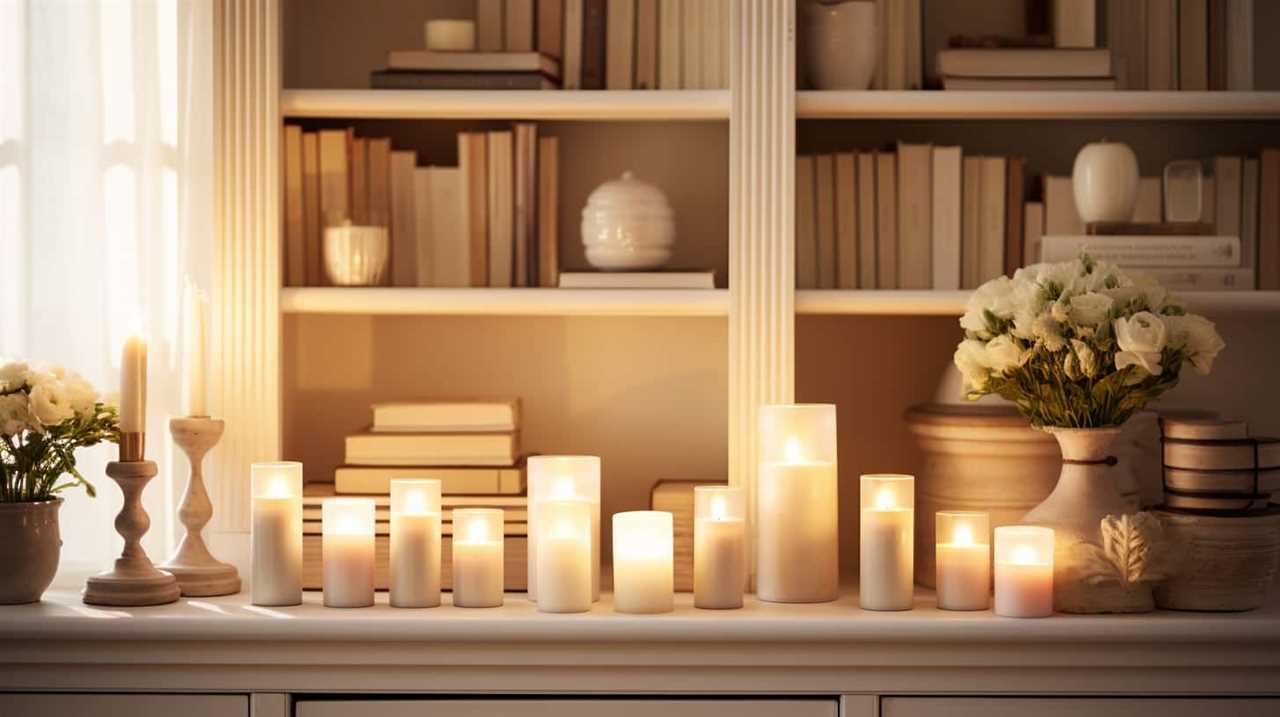
| Drawing Techniques | Shading Techniques |
|---|---|
| Contour drawing | Hatching |
| Gesture drawing | Cross-hatching |
| Proportional drawing | Stippling |
| Blocking-in | Blending |
Adding Details to the Candle Base
Now that we’ve sketched out the basic shape of the melting candle, it’s time to add some details to the candle base to make it more visually appealing.
Enhancing the candle base can be achieved by adding decorative elements such as intricate patterns, texture, or even small ornaments.
These details won’t only make the candle base more interesting to look at but also add depth and dimension to the overall drawing.
Let’s explore some creative ways to enhance the candle base and bring our drawing to life.

Enhancing Candle Base
In this section, we’ll focus on enhancing the candle base by adding intricate details. The candle base design plays a crucial role in creating a visually appealing and realistic drawing of a melting candle.
To achieve mastery in this area, consider the following tips:
- Explore decorative candle holders: Research different types of candle holders to gain inspiration for your drawing. Look for unique shapes, patterns, and textures that can be incorporated into the candle base design.
- Incorporate intricate patterns: Add depth and complexity to the candle base by incorporating intricate patterns. Experiment with swirls, floral motifs, or geometric designs to make your drawing more visually interesting.
Decorative Elements for Base
Our first step in enhancing the candle base is to incorporate decorative elements that add detail and visual interest. We can experiment with different color combinations to make the base stand out and complement the overall composition. For example, using warm colors like red, orange, and yellow can give the illusion of a flickering flame, while cool colors like blue and purple can create a calming effect.
When it comes to drawing techniques, we can use various lines and patterns to create intricate designs on the base of our melting candle. We can add small embellishments such as flowers, leaves, or swirls to add a touch of elegance and sophistication.
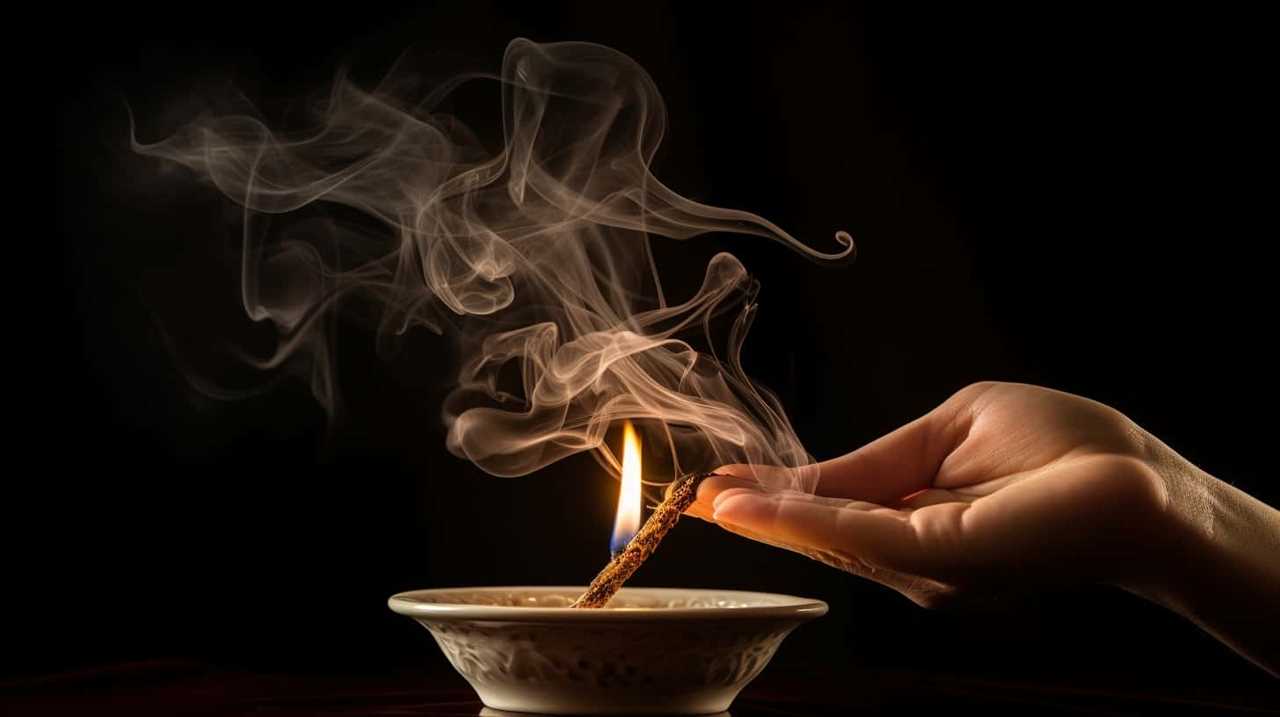
These decorative elements will elevate the candle base and make our drawing more captivating.
Drawing the Melted Wax
We can start drawing the melted wax by creating irregular, flowing shapes using a series of curved lines. The melted wax should have a sense of movement and liquidity, so it’s important to vary the size and shape of the drips.
To add depth and realism to the drawing, we can incorporate two sub-lists:
- Creating Wax Drips:
- Begin by lightly sketching the outline of the drips using curved lines that taper at the ends.
- Use a darker shade of the candle’s color to fill in the drips, gradually blending it with lighter tones towards the edges.
- Blending Colors:
- To achieve a smooth transition between colors, gently blend them together using a blending stump or a soft brush.
- Don’t forget to add highlights and shadows to create a three-dimensional effect.
By mastering these techniques, we can create a realistic depiction of melting wax that adds a touch of authenticity to our drawing.

In the next section, we’ll explore the process of creating realistic drips that enhance the overall appearance of the candle.
Creating Realistic Drips
To create realistic drips, it’s important to carefully observe the flow and shape of melting wax. The aim is to capture the essence of a melting candle, creating an illusion of realism in your drawing.
Start by studying the way the wax flows down the sides of the candle. Notice how it clings to the edges and forms irregular shapes as it drips. Use light, flowing strokes to recreate these shapes, ensuring they follow the direction of gravity.
Vary the length and thickness of the drips to add depth and dimension to your drawing. By paying close attention to these details, you can create the illusion of melting wax that appears incredibly lifelike.

Now, let’s move on to the next step: adding texture to the candle.
Adding Texture to the Candle
Now let’s talk about adding texture to our melting candle drawing.
Texture is what gives our artwork depth and makes it look more realistic.
There are different techniques we can use to create texture on the candle, such as cross-hatching, stippling, or using a texture tool.
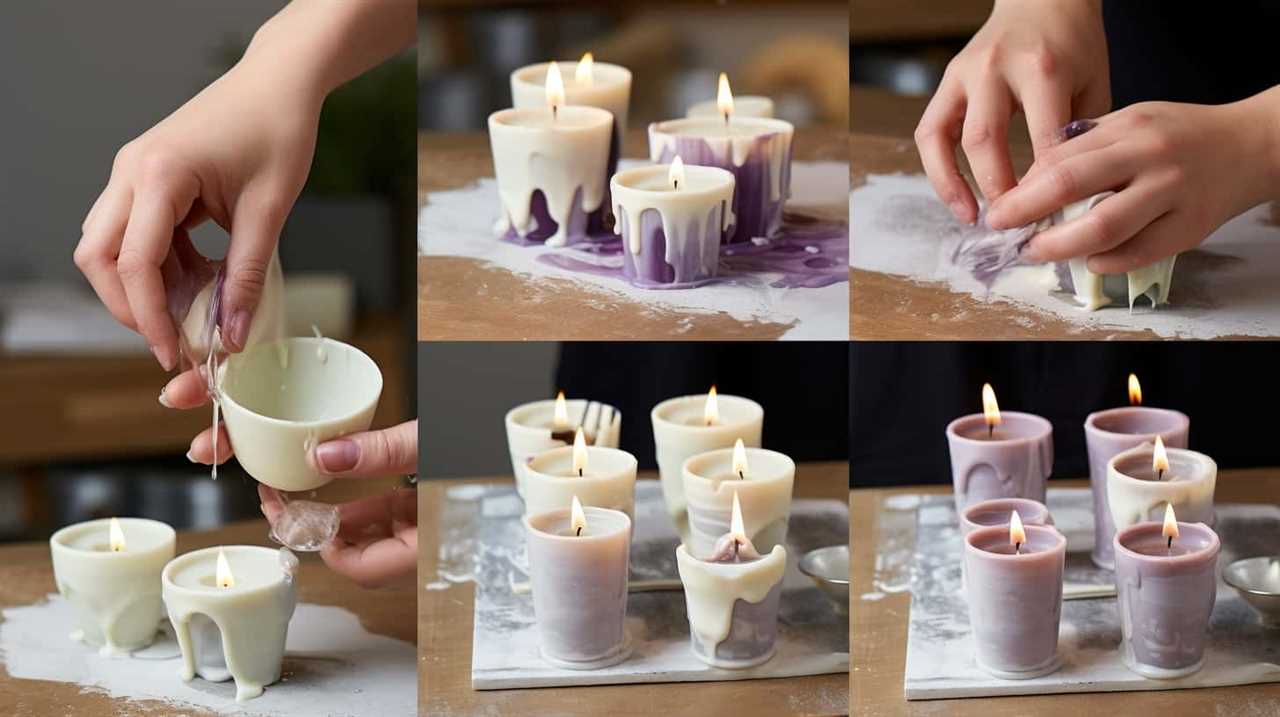
Different Texture Techniques
Using a combination of strokes and shading, we can create texture on the surface of the melting candle. This adds depth and realism to our drawing. To achieve different textures, we can utilize various materials and techniques.
Here are two sub-lists to explore:
- Different Materials:
- Charcoal: Use charcoal for a rough, grainy texture. Apply it lightly to create a soft, powdery effect or press harder for a darker, coarser texture.
- Graphite Pencil: With a graphite pencil, we can create a smooth texture by applying even strokes. For a more uneven texture, vary the pressure and direction of the strokes.
- Creating Textures:
- Cross-hatching: Overlapping parallel lines create a textured effect. Vary the distance and angle between the lines to achieve different textures.
- Stippling: Dots or small dashes can be used to create a textured appearance. Vary the density and size of the dots to create different effects.
With these techniques and materials, we can add texture to our melting candle drawing, making it more visually captivating.
Enhancing Realism With Texture
We can further enhance the realism of our melting candle drawing by incorporating texture onto the surface. By adding texture, we can bring life to the candle, making it appear more realistic and three-dimensional. There are various techniques for creating texture in drawings, and each type of candle requires a different approach. To illustrate this, let’s take a look at the following table:
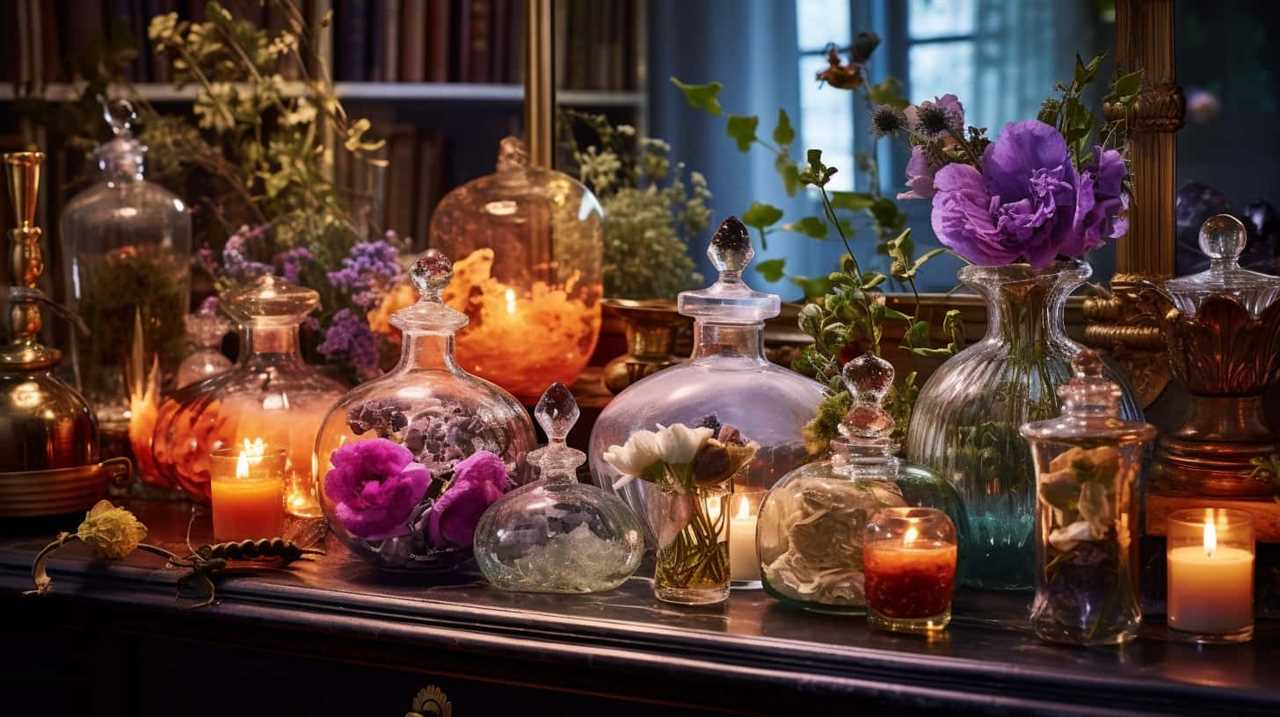
| Candle Type | Texture Technique |
|---|---|
| Beeswax | Cross-hatching |
| Paraffin | Stippling |
| Soy | Scribbling |
The choice of technique depends on the texture and appearance of the specific candle you are drawing. Now that we have discussed enhancing realism with texture, let’s move on to the next step: shading and highlighting the candle, which will further add depth and dimension to our drawing.
Shading and Highlighting the Candle
To achieve a realistic effect, we can enhance the appearance of our melting candle by applying shading and highlighting techniques.
Shading techniques are essential for creating depth and dimension on the candle’s surface. By using darker tones and gradually blending them with lighter ones, we can simulate the play of light and shadow. This adds volume and realism to the drawing.
On the other hand, highlighting techniques allow us to capture the reflective properties of wax. By carefully selecting areas that catch the light, such as the top edges and the melted parts, we can create a sense of luminosity and translucency.
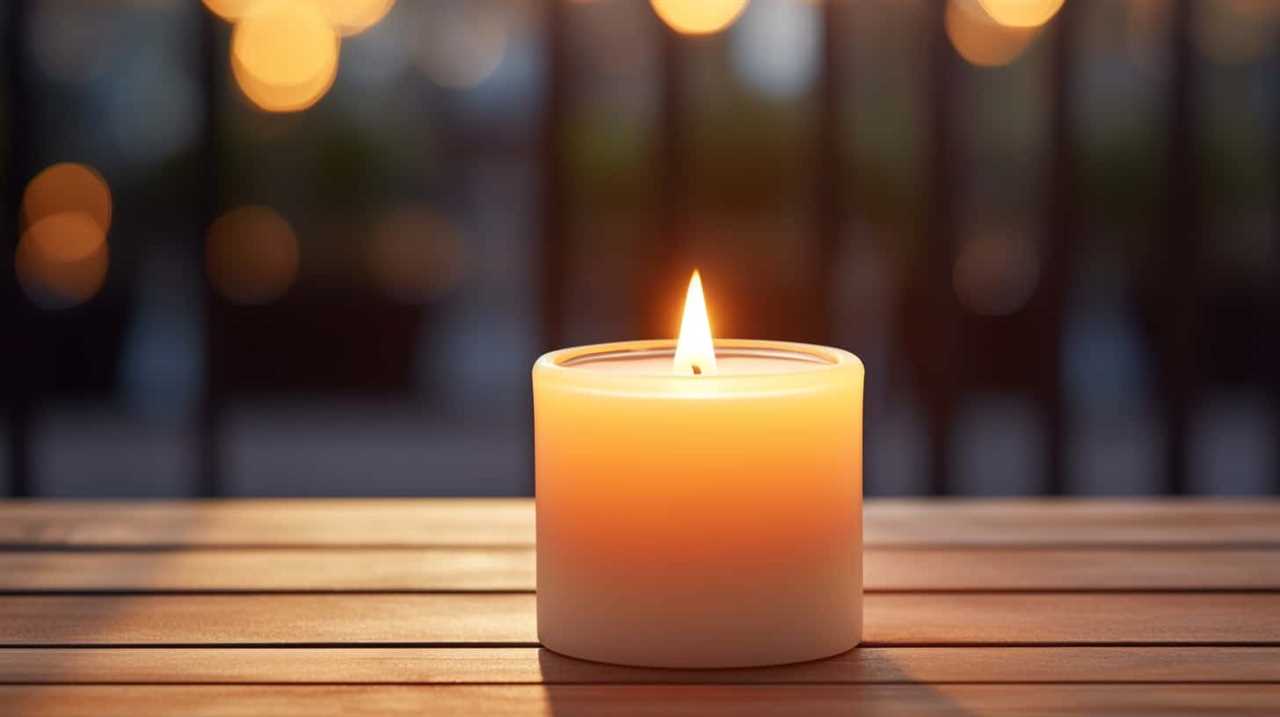
This contrast between light and dark areas is crucial for achieving a convincing representation of a melting candle.
Drawing the Flame
When it comes to drawing the flame of a melting candle, there are several key points to consider.
First, flame shape variations are crucial in capturing the unique character of each candle. From tall and slender to flickering and wide, flames can add depth and interest to your artwork.
Additionally, capturing movement and light is essential to creating a realistic flame. By observing the way the flame dances and illuminates its surroundings, you can bring your drawing to life.

Lastly, don’t forget to add realistic shadows to enhance the three-dimensional effect of the flame and make it appear more dynamic.
Mastering these points will help you create a captivating and believable melting candle drawing.
Flame Shape Variations
To draw the flame of the melting candle, we can explore various shape variations. The shape of a flame can vary depending on its intensity, movement, and the type of fuel being burned. Here are some shape variations to consider:
- Pointed Flame:
- This is the most common flame shape, with a pointed tip and a wider base.
- It represents a stable and steady flame.
- To create a melting effect, add irregularities along the edges of the flame.
- Dancing Flame:
- This flame shape has a more curvy and wavy appearance.
- It represents a flickering flame, as if it’s dancing in the wind.
- To mimic movement, draw the curves with fluid strokes, making them uneven and asymmetrical.
By experimenting with these shape variations, you can add depth and dimension to your drawing of the melting candle’s flame.
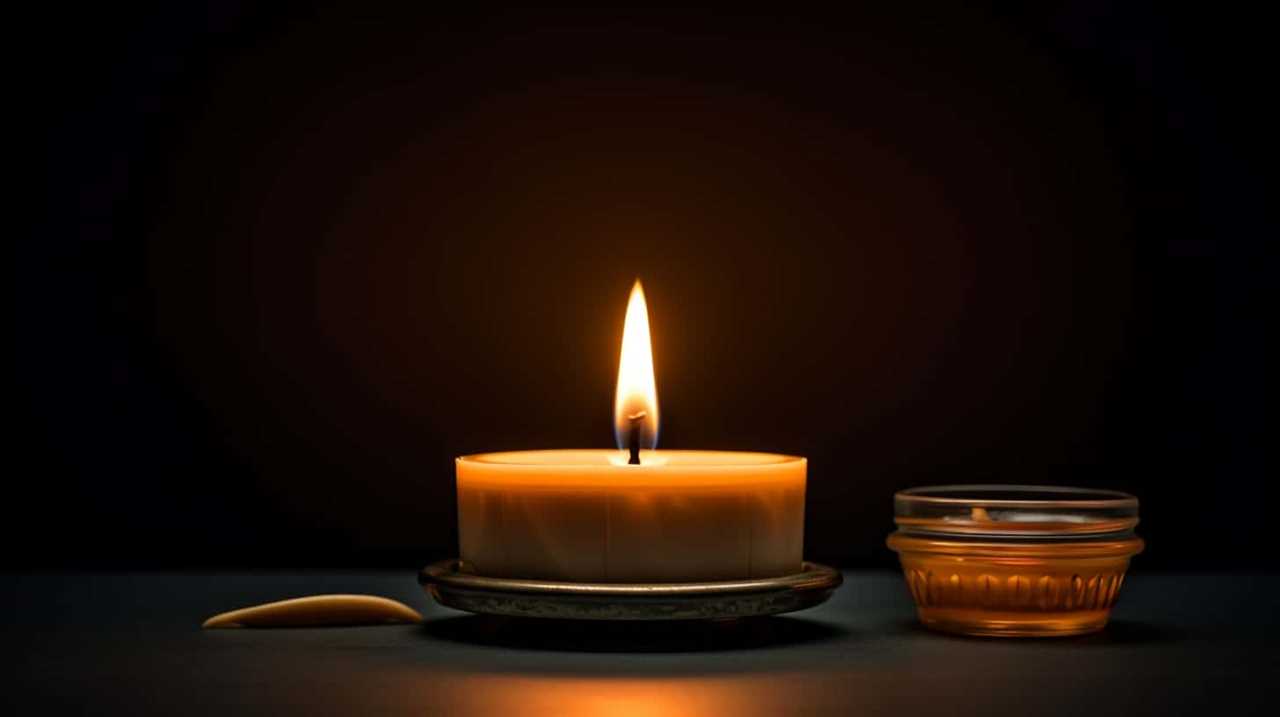
Transitioning into the next section, capturing movement and light, will further enhance the realism of your artwork.
Capturing Movement and Light
Let’s capture the movement and light of the flame by skillfully drawing its flickering and illuminating qualities. To create a sense of movement through line and shape, start by observing the flame’s dynamic nature. Notice how it dances and sways, constantly changing its form. Use quick, curved lines to depict this constant motion. The play of light and shadow on the melting wax is another important element to capture. To emphasize this, vary the thickness and darkness of your lines. Additionally, shading the areas where the light hits the wax will help create a three-dimensional effect. To further enhance the sense of movement, consider adding wisps of smoke trailing off from the flame. Remember, mastering the art of capturing movement and light will bring your melting candle drawing to life.
| Capturing Movement and Light |
|---|
| Observe the flame’s dynamic nature |
| Use quick, curved lines to depict movement |
| Vary line thickness and darkness |
| Shade areas where light hits the wax |
| Add wisps of smoke for extra movement |
Adding Realistic Shadows
To enhance the overall realism and dimension of the melting candle drawing, we can now focus on adding realistic shadows to accurately depict the flame. When it comes to creating shadows, blending techniques are essential for achieving a natural and realistic look.
By using techniques such as smudging or softly blending different shades of gray or black, we can create depth and form within the flame. Additionally, cross hatching can be used to create shadow effects by drawing a series of parallel lines in different directions to mimic the texture and shading of the flame.
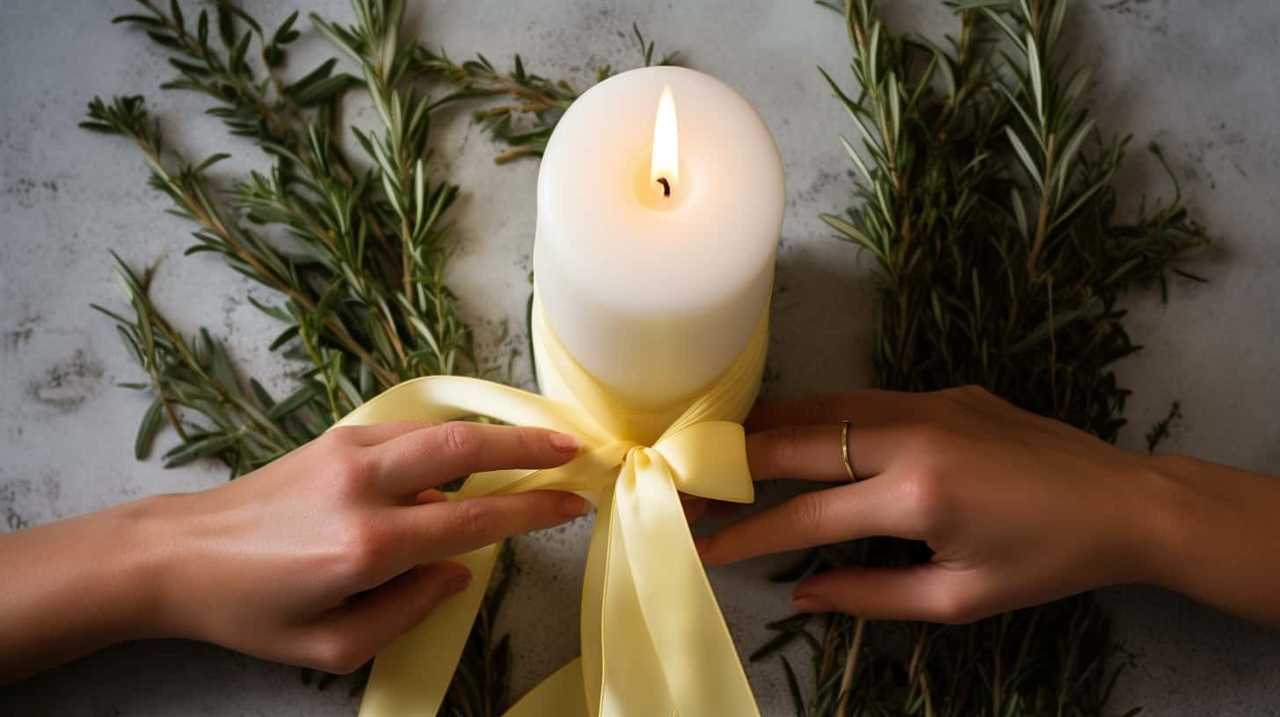
These techniques allow us to capture the subtle variations in light and shadow, bringing the flame to life on the page.
As we delve into the next section about adding reflections and glow, we’ll explore how to further enhance the realism of our melting candle drawing.
Adding Reflections and Glow
We enhance our drawing of a melting candle by incorporating reflections and a glowing effect.
To create realistic reflections, we first identify the light source and determine where it would hit the candle’s surface. Using a lighter shade of the candle’s color, we carefully add highlights to represent the reflection of the light. These highlights should be placed on the areas that would catch the most light, such as the wax drips or the curved surface of the melting candle.
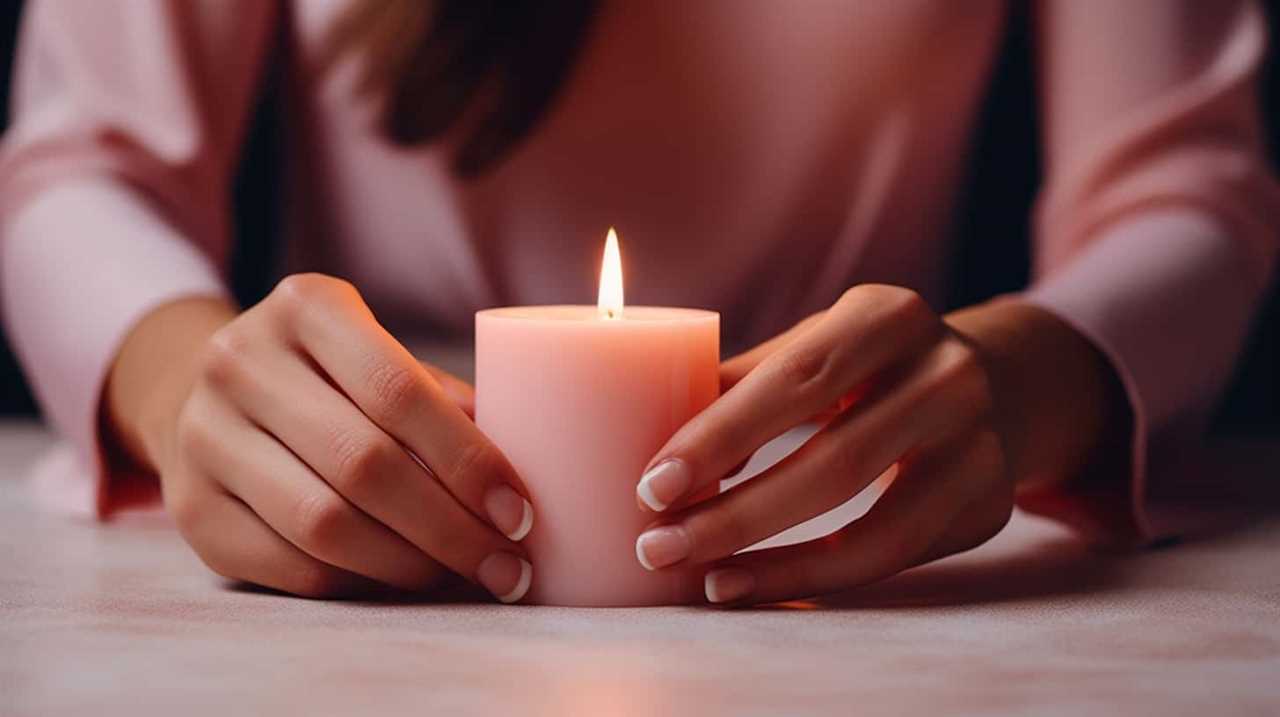
Next, to achieve a glowing effect, we can use a soft, translucent color for the candle’s flame and the melted wax. By lightly layering this color and blending it with the surrounding areas, we can create the illusion of a warm, radiant glow emanating from the candle. Remember to adjust the intensity and size of the glow based on the candle’s proximity to other objects or surfaces.
With these techniques, our drawing of a melting candle will come to life with beautiful reflections and a mesmerizing glow.
Enhancing the Background
To further enhance the overall composition of our drawing, we can focus on enhancing the background. This step is crucial in creating depth and bringing our melting candle to life. There are two key techniques we can utilize to achieve this: using contrasting colors and incorporating patterns and textures.
- Using Contrasting Colors:
By using colors that are opposite on the color wheel, we can create a dynamic and visually appealing background. For example, if our candle is predominantly warm-toned, we can use cool-toned colors in the background to make it stand out even more. - Incorporating Patterns and Textures:
Adding patterns and textures to the background can add complexity and interest to the overall composition. We can experiment with various techniques such as stippling, hatching, or even using patterned paper as a backdrop.
Adding Depth and Dimension
To create a more realistic and three-dimensional effect, we can employ shading techniques in our drawing. Adding depth and dimension to our melting candle drawing is crucial in achieving a lifelike appearance.

One technique we can use is called hatching, which involves creating parallel lines to indicate shadows and shading. By varying the spacing and thickness of these lines, we can create a sense of depth and form.
Another technique is cross-hatching, where we layer crisscrossing lines to add even more dimension.
Additionally, we can use blending tools such as tortillons or blending stumps to soften and smooth out the shading, creating a seamless transition between light and dark areas.
Remember to observe the light source and shadows to accurately depict the melting candle’s three-dimensional shape.
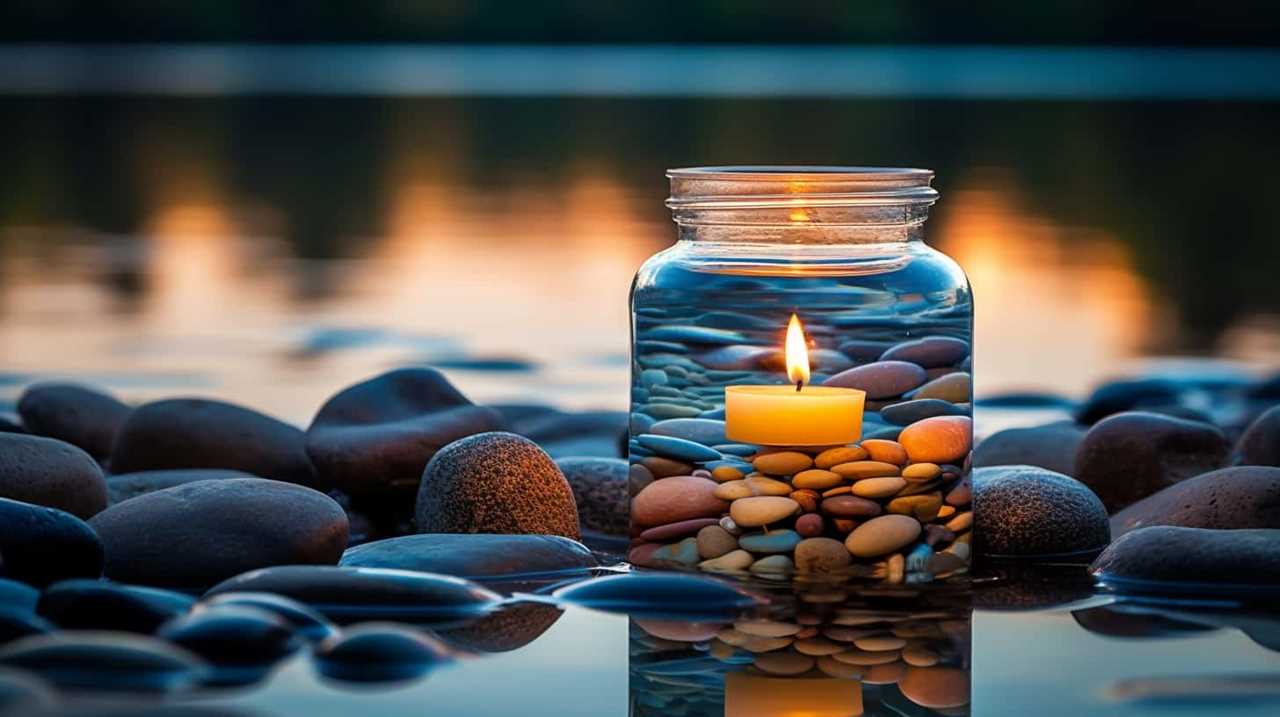
Fine-Tuning Your Drawing
Fine-tuning our drawing involves applying additional details and refining the overall composition to further enhance the realistic representation of the melting candle. To improve your technique and take your drawing to the next level, consider exploring different mediums and methods. Here are some tips to help you in this process:
- Experiment with shading techniques such as cross-hatching and stippling to create realistic shadows and highlights.
- Pay attention to the texture of the candle, using techniques like blending or layering to add depth and dimension.
- Try using different drawing tools such as charcoal, graphite, or colored pencils to achieve different effects.
- Practice adding fine details like the dripping wax or the texture of the candle’s surface.
By incorporating these techniques and exploring different mediums, you can refine your drawing and achieve a more realistic representation.
Now, let’s move on to the next section and discuss some tips for adding color (optional).
Tips for Adding Color (Optional)
To add depth and vibrancy to our melting candle drawing, we can explore different techniques for incorporating color.

One method is to use colored pencils to create gradients. Gradients are gradual transitions of color from light to dark or vice versa. By layering different shades of color, we can achieve a realistic and three-dimensional effect.
Start by lightly applying the lighter shade and gradually build up the intensity by adding more layers with darker shades. Blend the colors smoothly using gentle strokes or a blending tool. Experiment with different color combinations to achieve the desired effect.
Remember to observe the light source and apply the shadows accordingly. With patience and practice, we can bring our melting candle drawing to life with vibrant and realistic colors.
Frequently Asked Questions
Can I Use Colored Pencils Instead of Graphite Pencils for Sketching the Basic Shape?
Yes, we can use colored pencils instead of graphite pencils for sketching the basic shape. They offer a vibrant alternative and can add depth to your drawing. To blend them effectively, start with light layers and gradually build up the colors.
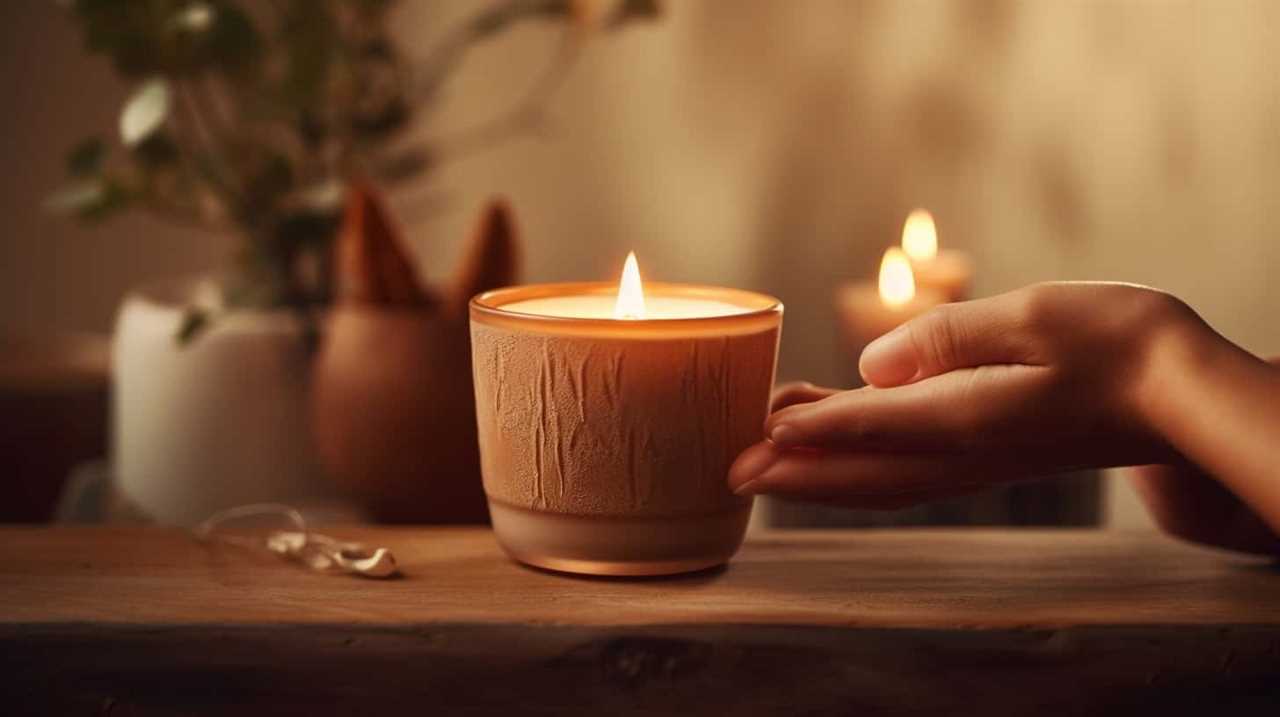
How Long Does It Usually Take to Draw a Melting Candle?
Drawing a melting candle can be a captivating experience, allowing us to explore the beauty of fluidity and motion. Achieving smooth transitions and adding movement can take time, but the end result is worth it.
What Are Some Techniques for Creating Realistic Wax Drips?
Creating texture with pencil strokes and using blending techniques for smoother wax drips are essential for creating realistic wax drips in a drawing. Our mastery of these techniques allows us to bring a melting candle to life on paper.
Are There Any Specific Shading Techniques That Work Best for Drawing Candles?
Blending techniques and cross-hatching methods are effective for shading candles. By skillfully blending different tones and using precise cross-hatching strokes, we can create realistic shadows and highlights, enhancing the three-dimensional quality of our candle drawings.
What Type of Paper Is Recommended for This Drawing?
For this drawing, we recommend using a heavyweight drawing paper to handle the shading and blending techniques. As for sketching, alternative pencils like charcoal or graphite can create beautiful textures and depth.
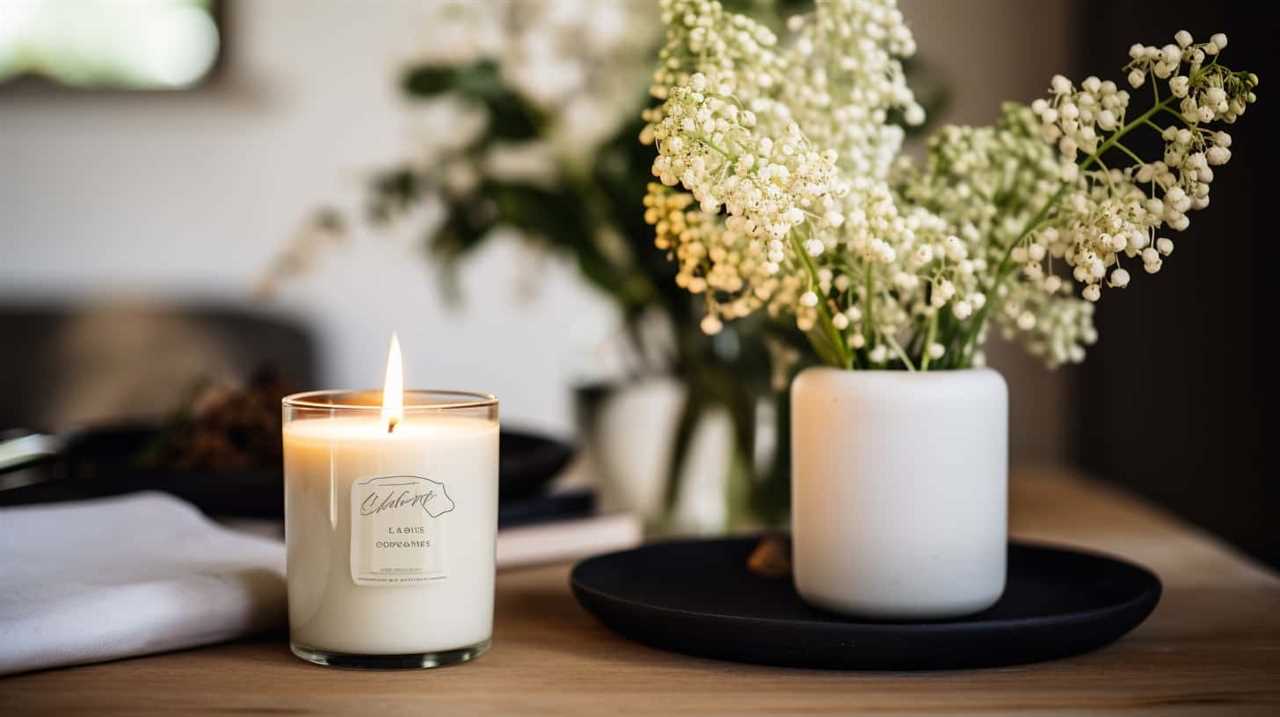
Conclusion
As we put our pencil down, we marvel at the melting candle before us. Its waxy body slowly transforming, as if surrendering to the inevitable passage of time.
Just like the candle, our lives too go through seasons of change and transformation.
May this simple drawing serve as a reminder to embrace the beauty of impermanence and find solace in the flickering flame of our own existence.









